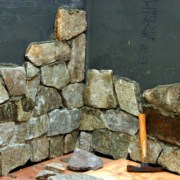Masonry veneer mortar
Long lasting results with masonry veneer mortar
Masonry veneer is a very popular choice for interior and exterior walls as well as fireplaces and numerous other applications. It creates a stone or brick like surface but provides better economy and offers more possibilities for sufficient insulation. The key to successful masonry veneer installation is divided to veneer type, professional workmanship and high quality materials including masonry veneer mortar (or adhesive), water and air barriers as well as pointing mortar.
Traditional vs. modern masonry veneer installation systems
The most common reason for failure of masonry veneer installations is delamination caused by water intrusion. Poor choice of water and air barrier materials and masonry veneer mortar may encourage water intrusion. Therefore, the choice of these materials should be carefully thought through.
Traditionally, the veneer installation process starts with two layers of felt paper on which metal lath is installed. The lath is coated with a mixture which consists of regular sand and masonry cement. The veneer is placed on the prepared substrate by applying masonry veneer mortar to the back of the tile before placing it its spot. The tile must be held in place to make sure it sticks. It cannot be moved once it is put on the substrate. The problem with the traditional masonry veneer adhesive is its strength which is not suitable for heavy duty vertical bonding. Fortunately, masonry veneer adhesive mortars have been developed especially for this purpose.
Polymer enhanced mortar for masonry veneer
The more modern technology for masonry veneer adhesive includes polymer enhanced systems which overcome the two issues experienced when working with traditional mortar: delamination by water intrusion and poor bonding strength on vertical substrates.
Instead of regular sand-cement mortar, the substrate should be prepared by applying two or more coats of air and water barrier in order to create a membrane that does not let any air or moisture through. Get more information on suitable air and water barrier products by contacting us.

The polymer enhanced masonry veneer mortar comes in a powder form, much like regular mortar, and it is mixed with water prior to application. The masonry veneer adhesive can be applied in two ways:
- Back of the tile: first a skim coat is applied to the back of the tile followed by a thicker layer of mortar. The tile is then placed on the substrate, slid an inch or two from its place and moved back to the final position. This is done to ensure good adhesion.
- Mortar bed: a faster method of working is when the veneer mortar is applied on the substrate and the skim coated tiles are pressed on it. Also when using this method, the tile should be slid back and forth from its place to guarantee adhesion.
Technical information, product suggestions and training possibilities are available upon request.
Benefits of polymer fortified masonry veneer adhesive
The polymer enhanced mortar systems for veneer have several properties that make them the go-to choice. The most remarkable benefits include:
- No sagging: regardless of the application method, polymer fortified adhesives do not cause the masonry veneer to sag guaranteeing long lasting results on facades, fireplaces and other vertical surfaces.
- Antimicrobial: especially the mortar systems approved for exterior use are often resistant to microorganisms, which prevents growth of mold and mildew.
- VOC free: most mortar systems come as a powder which is mixed with water. The systems cure as the water evaporates. No solvents are involved in the process, which results in zero VOC products.
Buying masonry veneer mortar of quality
One of the most important factors that encourage successful masonry veneer installation is the type of mortar used to bond the tiles to the substrate. If you are looking for a high quality masonry veneer mortar system, do not hesitate to contact us. Our experts are happy to help you find the right products for your project.



